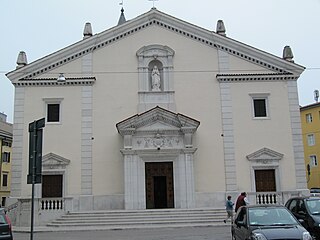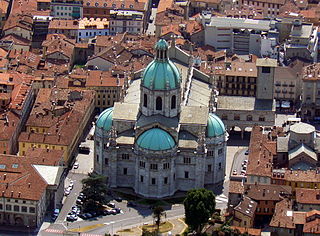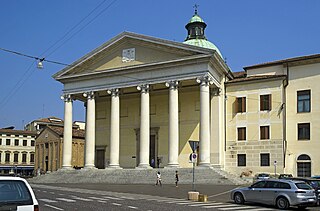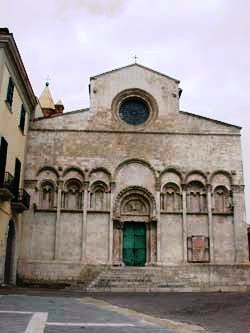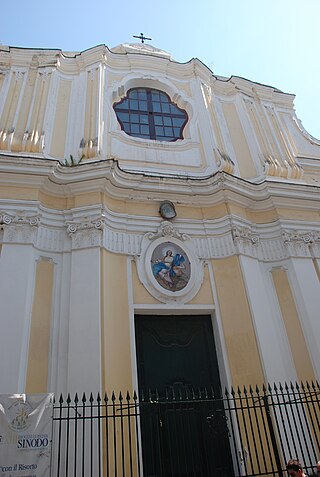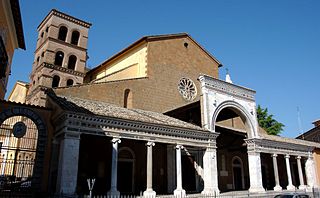Provincial reorganizations
The diocese of Trieste was suffragan of the Patriarchate of Aquileia until 1751. [4] The ecclesiastical province of Aquileia was subject to repeated troubles, both internal and external, due partly to the fact that the eastern dioceses of the province (Istria) were politically subject to Austria, while the western dioceses (Veneto) were subject to the Venetian Republic. Both powers had repeated clashes with the Papacy in policy and administration. [5] The War of the Austrian Succession (1740–1748) produced a crisis, since both Venice and the Papacy supported Charles Albert of Bavaria, [6] while Austria supported Maria Theresa, daughter of Charles VI, Holy Roman Emperor. The Austrian government retaliated by sequestering all church benefices in its territories. [7] At the conclusion of the war, both Austria and Venice demanded a resolution of the ecclesiastical problems.
Pope Benedict, in letters of 29 November 1749 and 27 June 1750, invited the two parties to come to an agreement, while for the moment the present arrangements would remain in effect. On 6 April 1751, replies from Austria and Venice were presented to the pope, in the form of a convention between the parties, with the demand that the pope implement it. [8] The patriarchate of Aquileia was abolished, as Article I of their convention required, and was replaced by two ecclesiastical provinces and two archbishoprics on equal footing: Udine and Gorizia. Benedict XIV granted the empress of Austria and her successors the right to nominate the archbishop of Gorizia, and the doge of Venice and his successors the right to nominate to a vacancy at Udine. [9] The diocese of Trieste was transferred to the ecclesiastical province of Gorizia. [10]
From 1788, a series of administrative changes took place in northeastern Italy. The bishop of Pedena, Aldrago Antonin de Piccardi had been transferred to the diocese of Senj e Modruš (Croatia) on 14 February 1785, and was not replaced. On 20 August 1788, diocese of Pedena, was suppressed, and its territory was added to that of Gradisca. [11] Under pressure from Emperor Joseph II, Pope Pius VI then abolished the diocese of Trieste and Archdiocese of Gorizia in 1788, merging them into the new diocese of Gradisca. [12] On 12 September 1791, at the request of Joseph's brother, Emperor Leopold II, Pope Pius VI divided the diocese of Gradisca into the newly created diocese of Gorizia-Gradisca, or Görz-Gradisca, [13] and a re-established diocese of Trieste, [14] appointing as its bishop the tutor of the Emperor's children, Sigismund Anton, Count of Hohenwart. [15] At the same time, the pope confirmed the right of the emperors to nominate to a vacancy in the diocese of Trieste. [16] Later attempts were made to suppress the see again, but the emperor decreed its preservation, nominating Ignatius Cajetanus von Buset zu Faistenberg bishop of Trieste on 12 February 1796. [17] After his death in 1803 the see remained vacant for eighteen years, because of the disorders caused by the French Revolutionary Republic, the Italian republics and kingdom of Napoleon, the dissolution of the Holy Roman Empire, and the imprisonment of Pope Pius VII from 1809 to 1815.
Emperor Franz II finally appointed Antonio Leonardis da Lucinico as the new bishop of Trieste on 4 March 1821, and he was confirmed by Pope Pius VII on 13 August 1821. [18] But the Emperor and Clemens von Metternich continually resisted the efforts to establish a concordat with the Papacy. [19]
On 20 June 1828, by the papal bull "Locum Beati Petri", Pope Leo XII completed the project which had been begun by Pius VII, the reorganization of the dioceses of the Italian peninsula, Istria, and Dalmatia, whose existence had been interrupted or compromised by the French intrusions. He first suppressed a number of dioceses in Istria and Dalmatia, including Aemonia. [20] The diocese of Koper, or Capodistria-Koper, was united with Trieste. [21] Thereafter it was known as the "Diocese of Trieste-Koper (Capodistria)". [22]
Bishop Bartholomew Legat was present at the Synod of Vienna in April 1849, when the Austrian Episcopal Conference was founded. [23] He also defended the views of the minority in the First Vatican Council (1869–1870). In 1909 Bishop Franz Xaver Nagl was appointed coadjutor cum jure successionis to the ninety-year-old Cardinal Prince-Archbishop Anton Gruscha of Vienna.
The Second Vatican Council (1962–1965), in order to ensure that all Catholics received proper spiritual attention, decreed the reorganization of the diocesan structure of Italy and the consolidation of small and struggling dioceses. [24] Pope Paul VI had been working for some time to implement the council's decree. The diocese of Trieste e Capodistria was in an anomalous position, with part of its territory in Italy, and part in the Slovenian Socialist Republic of Yugoslavia. On 27 October 1977, by virtue of the Apostolic Constitution "Prioribus saeculi XIX annis," Koper / Capodistria was restored [25] as an independent diocese once more, being transferred to the ecclesiastical province of Ljubljana from that of Gorizia, and leaving the diocese of Trieste in its present state. [26]


